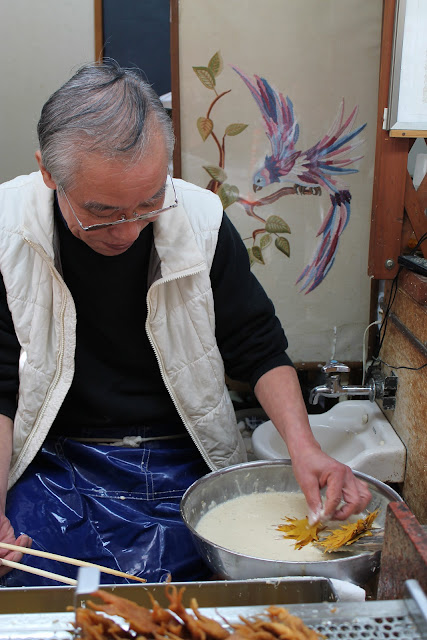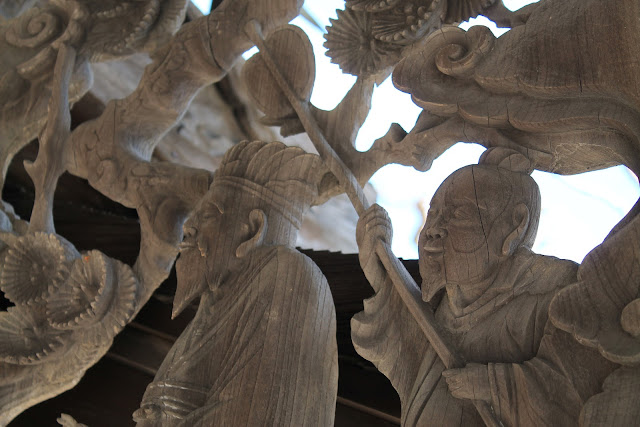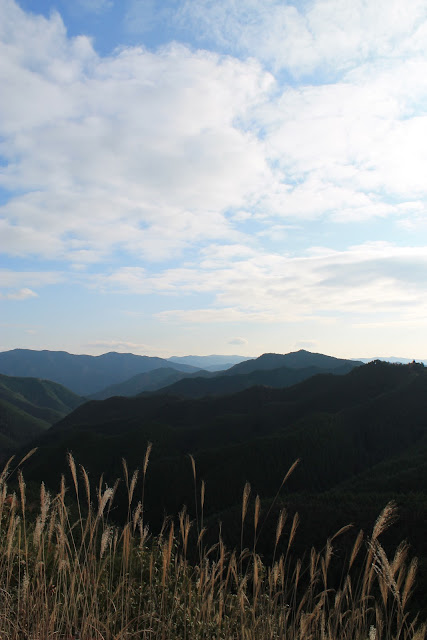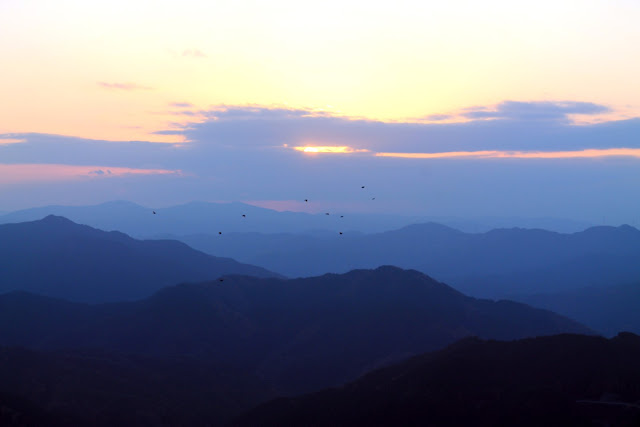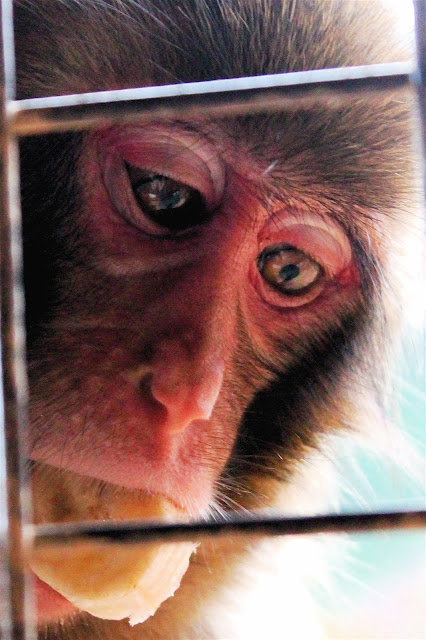This post is the second and final installment about my food adventures in Osaka. I've eaten a good many adventurous delectables over the second half of my time in Japan, and what follows are just some quick highlights.
Minoh, a town on the outskirts of Osaka, known for its beautiful waterfall, is also known for two types of quaint, local cuisine. The first is what's called Momiji Tempura. Momiji is the Japanese word for maple leaf, so as you might expect, this delightful dish consists of tempura-fried autumn maple leaves.
The batter is a little thicker than your average tempura, and is sweetened considerably, so what you get is really like a crunchy donut-like covering surrounding the leaves. It was my favorite omiyage (souvenir) food that I ever brought back for our Japanese roommates, but they didn't get the added bonus of watching the street vendors make it in their stands right in front of them, and also didn't get to eat it hot like I did.
The other food Minoh is known for is also, coincidentally, called Momiji. But this is Momiji of a different variety entirely. Momiji is also the local dialect's word for Venison meat. As I walked around the town, I never knew which kind the signs meant when they had ももじ written in hiragana syllables on the outside of the vendors.
I tried both, of course. The above was a Venison curry I had, and I had a Venison burger on a return trip to Minoh. I had had venison once in the states before, but with the holy "messengers of the gods" deer of Nara (remember them?) weighing heavily on my mind, it was a bit of a different experience.
One of the best street snacks as the weather got colder, though, was roasted chestnuts. They were available pretty frequently on most of my journeys and adventures, and made the perfect warm pick-me-up energy booster when skies were grey.
One of my favorite "only in Japan" snacks was this Giraffe Banana Cream Puff that Haruna brought us back as omiyage from a trip to Tokyo. It was delicious, but so weird looking.
In Japan, like never before, I had occasion to eat prawns... whole prawns. The brains and guts and everything. Again, really weird, but I always liked it.
The one Japanese meal that was actually difficult for me to stomach was the breakfast on our overnight trip to Mie prefecture. We stayed in a traditional Ryokan and ate traditional Japanese meals for dinner and breakfast. The dinner was an absolute feast filled with all the delights of a traditional Japanese meal, and so was the breakfast. But the problem was I just couldn't bring myself to devour it all in the a.m. hours the same way I could any other time in Japan. The umeboshi (Japanese pickled salt plums) really did me in, and for the first time, I couldn't bring myself to finish my meal.
By the end of November, we Americans were really beginning to crave the flavors of home. I never EVER thought I would get tired of Japanese food, my all-time favorite world cuisine. But after 3 months, the three of us Sofia Americans were really craving American cuisine, badly. We got our frustrations out by going to McDonalds (the first time I've been to one since I was 12, but I guess once every decade or so isn't so bad, right?), Domino's pizza, and Gasto (an "American" style food restaurant roughly equivalent to Denny's or Applebee's, but where burgers come with rice instead of buns, among other quirky Japanisms). Needless to say, we were thrilled to be invited to this Thanksgiving cocktail party by our internship supervisor, and chowed down on some American favorites.
Mister Donut was also a favorite hang-out on weekends. This Japanese donut shop occasionally had little American favorites, like these Peanuts-themed cupcakes.
After a couple solid weeks of gastronomical homesickness, I was back to loving all things Japanese again. If you can remember back to when Michael and I went to San Francisco over the summer to get my Japanese visa, and stumbled upon that Japanese candy shop, then you might be able to picture the candy shop where these treats came from. This shop is just one of the places where my Japanese roommate, Ai, worked part-time during the week. I enjoyed going there a handful of times and picking out special treats for myself and the housemates.
After a hike I took with Ishani one rainy weekend day, we went to an outdoor onsen for the first time, and bathed among the mist-filled trees. It was really beautiful, and afterwards, we went to the attached restaurant and I dined on this wild boar nabe (hot-pot). The meat was so flavorful!
Osaka's street food is widely regarded as the best in Japan. I had lots of fun picking up little dishes whenever I went on long bike rides into the city, like this squid stick delicioiusness.
The last of Ariyama-san's (our landlady's) cultural events was an event making Mochi!! It was so much fun, and so nice taking part in the traditional mochi-making process. Mochi is literally just rice, but it's a special, slightly more glutenous variety that, when cooked and pounded, molds together into an excellent rice mold of goodness!
These were the mochi, filled with red bean paste that yours truly personally fashioned out of the mochi that all my housemates pounded together.
Lastly, one of the absolute highlights of Japan was real Kobe beef. I had put it off and put it off all semester, because it really is an expensive luxury food that I didn't know I'd be able to accurately budget for. But in the end, the experience was well, WELL worth the wait, and the cost.
Ishani and I went, and we split the cost by getting the most expensive kobe beef sirloin on the menu in combination with the cheapest (non-Kobe in the sense that it wasn't raised in the Kobe way, but was actually still Kobe beef in the fact that it was raised in Kobe) non-Kobe steak on the menu, which actually made an excellent taste test comparison item. The regular steak was so nicely cut and well-prepared on the Teppanyaki grill that it melted in your mouth, but the Kobe beef? There literally just aren't words to describe how good, how melty, how rich a texture!
I'll just tell you that despite waiting until the last full weekend in Japan to eat this treasure, I made time on my last night to go back AGAIN to "Steakland" restaurant with my cousin and get it before leaving Japan. That's how good it was.
I wish I could give you all a sample right now, but alas, as Kobe beef is ONLY available in Japan and to world royalty upon request (and anything in the US that claims to be Kobe beef is not real Kobe beef)... well, you'll just have to go to Japan to taste it for yourself.
